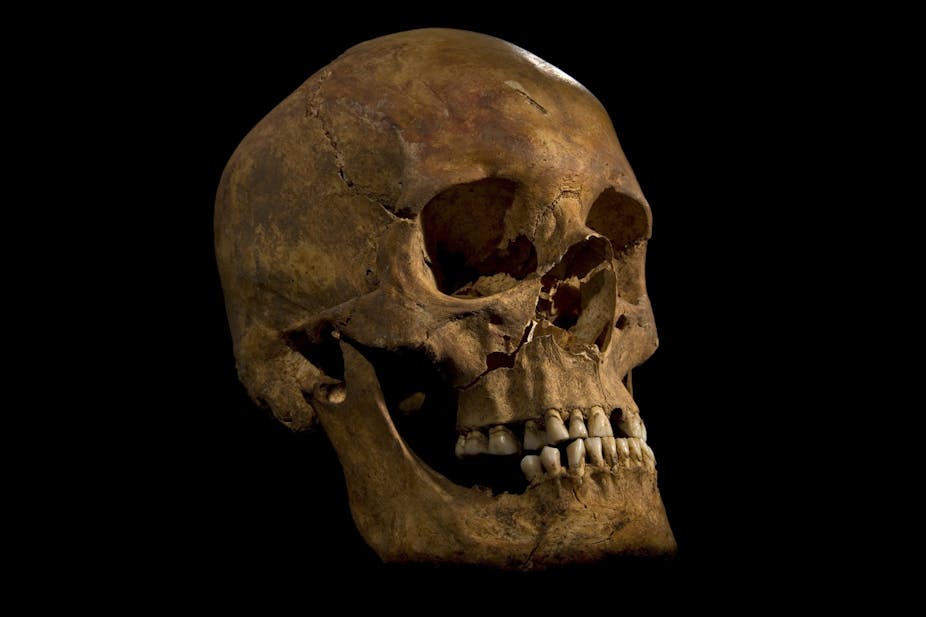In the past few days news has come to light of the confirmation that skeletal remains discovered in an excavated site of a Leicester car park are indeed that of the famous English king Richard III. But how was it done?
It should be noted that DNA played only a part in this puzzle, the project involved archaeologists, pathologists, genealogists and anthropologists.
It has been reported that testing produced a match with the maternal DNA of two descendants of Richard’s sister (one anonymous, and the other Michael Ibsen, a Canadian carpenter living in London). A “beyond reasonable doubt” match by all accounts.
So what does this actually mean and how can DNA be considered such a useful tool to identify the dead?
Most people who are interested in the field of forensic science would be familiar with DNA profiling. In shows such as CSI: Crime Scene Investigation it is used quickly and cleanly to great crime-fighting effect.
The reality of course is somewhat different, but in essence what you see on screen is as it occurs in the lab. The DNA used mostly in the criminal forensic realm is that termed “nuclear DNA”. This large DNA strand is found in the middle of most cells of the body, its role being to act as a blueprint for building and operating your body.
Its sequence is very unique. Your nuclear DNA is inherited in part from your father, and in part from your mother. The “letters” in their DNA codes combine to produce an approximately 3.2 billion base pair-long strand believed to be unlike anyone else’s (aside from an identical twin). It can be used to individualise biological evidence from crime scenes - effectively pinpointing an individual as the source.

When identifying bloodstains from a murder, or semen from a rape, this technique can be invaluable. Being a large molecule, however, nuclear DNA is susceptible to damage, which can be fatal to the scientist’s ability to read it’s code.
This means that when evidence items or biological material has been left exposed to the elements – such as moisture, sunlight, or chemical environments - its value for unique identification can be reduced. Enter mitochondrial DNA.
Mitochondrial DNA
Mitochondria are the power-houses of the cells. They are present in virtually all cells both plant and animal. They convert energy into forms that can be used to drive cellular reactions and processes.

This is the much neglected “other” DNA contained within our bodies, and it has been used effectively to identify skeletal remains from hundreds, even thousands of years past.
To make the regal link: recently mitochondrial work has been undertaken on Egyptian royal mummies from the Valley of the Kings. No less than Tutankhamen has had his familial relationships probed and documented via his mitochondrial DNA.
Moving further north, the Russian royal family (the Romanovs) were also identified after a grisly dispatch using the same process.
So why go down the mitochondrial path when nuclear DNA fails us?
In line with their functional importance, mitochondria are rewarded by both quantity and size in their cellular home. Your average cell contains hundreds or even thousands of circular mitochondrial DNA strands. This gives them an advantage over the more fragile, singular nuclear DNA. They are smaller, more robust and by weight of numbers - they are more likely to survive the slings and arrows of time and outrageous fortune.
The other advantage of mitochondrial DNA is that it is inherited solely on the maternal line. When egg and sperm combine at the moment of conception, the sperm tail containing the parental mitochondria is shed. The resulting embryo will now inherit the mitochondrial sequence from the mother. As there is no combining of codes the original sequence is (generally) maintained.

Less change and mutation means that even many generations down the line the sequence can be compared and matched. It also means when only distant relatives (such as maternal aunts or cousins etc) can be found for matching, a result is still possible. This kind of matching with standard nuclear DNA profiling is far less discerning.
So, where does this leave us with a king and a carpenter? King Richard and his sister would have inherited the same maternal mitochondrial DNA. This has in turn been carried down the line in Michael Ibsen’s family (thank goodness there appear to be no other skeletons in his family’s closet!).
A direct comparison would have been carried out, and (perhaps allowing for minimal mutation) a match would have been detected. A statistical analysis of the frequency of the profile within a population would have been undertaken and the result was such that scientists consider his identity “beyond reasonable doubt”.
It has been quipped that there is some irony in the fact that the man Shakespeare made famous for his “my kingdom for a horse” speech should be found in a car park. That aside, it is yet another testament to the value of the technique of DNA identification that makes a DNA scientist feel all warm and fuzzy.
Further reading:
A burial fit for a king: from car park to cathedral for Richard III - Peter Sherlock, The Conversation

